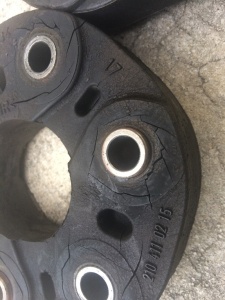It's not uncommon for RWD and AWD cars to exhibit driveline vibration at some point in their lives. Specifically, European vehicles can start to show failure at the giubo flex-joint. Pronounced "Gew-bo" though often misspelled and pronounced as "Guibo" (Gwee-bo). As I understand it, the name comes from the Italian for "joint," giunto, and its inventor Antonio Bosch. A joint is indeed what it is, and it usually links the transmission output to the propshaft. In some applications it can actually link the other end of the propshaft to the differential. Their use is pretty common in a lot of BMW and Mercedes vehicles.
Vibrations from the rear may be your first clue
The giubo is usually constructed of rubber with a fiber inner core - the key purpose of the joint is to minimize vibrations and allow a little bit of flex. Each bolt around the joint alternates between the transmission side and prop shaft side - so the two elements are joined only by the flexible rubber. I called this a maintenance item above because over time, torque and heat from the transmission will start to break down the rubber and cause joint failure. Given the core job of minimizing vibrations it stands to reason when the giubo starts to fail, vibrations from the rear may be your first clue. When the joint breaks down more it can actually feel like throttle lag to the driver, or a bump when coming on or off the throttle. This is because the joint is initially flexing internally rather than transmitting the full torque.

Example of a typical worn Giubo
Visual inspection is key to diagnosing a bad giubo, but can often be overlooked because on a lot of cars it's actually quite hard to see. There is easy access on the BMW X5 3.0i pictured here but many BMW 5, 6, 7 & 8 series cars have a dual exhaust running down the center line and the center box and heatshield obscure the giubo. You may need some small mirrors and flashlights to really get a good look. Any sign of torn or ripped rubber guarantees the joint needs replacement.
Failure of these can feel like a worn giubo
The other sometimes overlooked items I wanted to mention are mounting bushings for the engine, transmission and differential. Again these tend to be made of rubber and the primary purpose is to minimize vibration into the cabin. There are three common types - solid rubber, hollow (air filled), rubber, and fluid filled rubber. Failure of these elements can feel the same to the driver as a worn giubo - increased vibrations and 'thumps' when you go on and off throttle. A visual check followed up by a prybar check is still the best way to diagnose problems. But to be honest, it can be very easy to think a bad mount is good because sometimes you can have separation on the inner mounting side whilst the outer side looks and feels fine. As a rule of thumb, if your car is over 100,000 miles and you don't know when these mounts were last changed, it is worth replacing them regardless.












